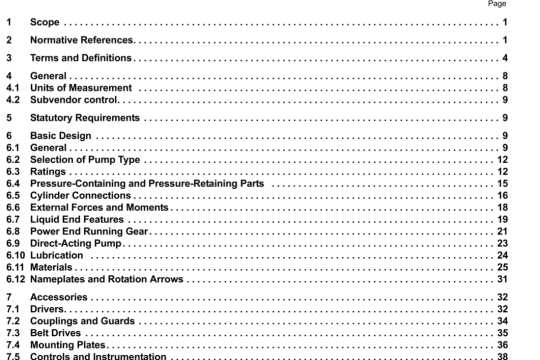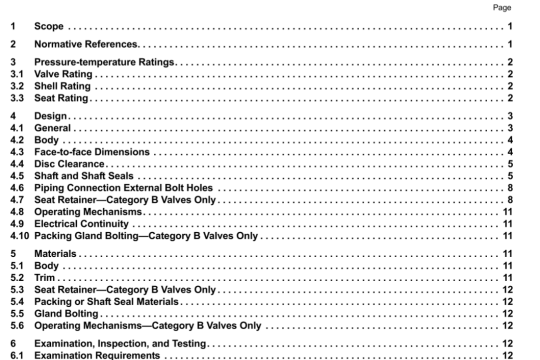API RP 64:2001(2012) pdf download
API RP 64:2001(2012) pdf download.Recommended Practice for Diverter Systems Equipment and Operations.
5.8.3 ClosIng Unit Backup System
A secondary means (backup system) should be employed to permit sequencing the diverter system should the primary cbs- ins system become inoperative. This may be accomplished by alteniative pump system capacity, separate isolated accumulator capacity. nitrogen backup capacity, or other means. The backup system should be automatically or selectively available on demand. The backup system should be included in diverter system testing and maintenance procedures.
5.8.4 Accumulator Recharging Capability
The pump system(s) should be capable of recharging the primary diverter control system accumulators to full system design pressure within five minutes or less after one complete divert mode operation of the diverter control system. This should be verified by fully charging the accumulators. isolating the pumps from service, and sequencing the divert functions using only the accumulators.
5.8.5 Pump Systems
A pump system consist.s of one or more pumps. Each pump system (primary and secondary) should have independent power soulves. such as electricity or air. The same pump system may be used to provide power fluid to the BOP smack and the divcrtcr system. Power for the closing unit pump(s) should be available to the accumulator unit at all times, such that the pump(s) automatically start when the closing unit manifold pressure has decreased to less thami 90% of the accumulator operating pressure. Similarly. the pump(s) should automatically stop when the full design accumulator charging pressure is reached.
5.8.5.1 Pump Pressure
Each closing unit should be equipped with a pump(s) that provides a discharge pressure at least equivalent to the working pressure rating of the closing unit.
5.8.5.2 Pressure Protection
Each pump system should be protected from over pressurization by a minimum of two devices to limit the pump discharge pressure. One device, normally a pressure limit switch, should limit the pump discharge pressure so that it will not exceed the working pressure rating of the diverter control system. The second device, normally a relief valve, should be sized to relieve at a flow rate at least equal to the designed flow rate of the pump systems and should be set to relieve at not more than 10% over the control unit working pressure. These pressure limiting devices should be installed directly in the control system supply line to the accumulators and should not have isolation valves or any other means that could defeat their intended purpose. If isolation valves are desired to permit service or testing of the pressure-limiting device, those valves should be car-sealed open. Rupture disc(s or relief valve(s) that do not automatically reset are not recommended.
5.8.6 Control System Valves, Fittings, Lines, and Manifolds
Additional infomiation and recommendations for closing units are found in API RP 53. That document describes recommended practices for surface and subsea installations.
5.8.6.1 Valves, Fittings, and Other Components
The divcrtcr control system should be equipped:
I. With a full-opening valve into which a separate fluids pump can be easily connected.
2. To allow isolation of the pumps and accumulators from the manifold and annular control circuits, for maintenance and repairs.
3. With pressure gauges to indicate: a) accumulator pressure. b) regulator manifold pressure. c) annular pressure. and d) air pressure. Control system pressure gauges should be calibrated at least once every year.
4. With necessary pressure regulators to permit manual control of system components within their rated working pressure.
5. With clearly marked controls to indicate which valve is operated and the position of the valve (i.e., open. closed. neutral).
5.8.6.2 Conformity of Piping Systems
All piping components and all threaded connections installed on the diverter control system should confonn to the design and tolerance specifications for American National Standards Taper Pipe Threads as specified in ANSI B 1.20.1. Pipe and pipe fittings should conform to specifications of ASME B3l.3. If weld fittings are used, the welder shall be certiticd fir the applicable procedure required. Welding should be perftwmed in accordance with a written weld procedure specification (WI’S). written and qualified in accordance with Article II of ASMIi Boiler ad Pressure Vessel Code, Section IX.




